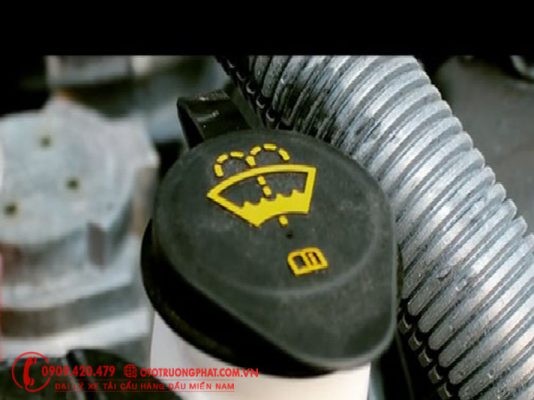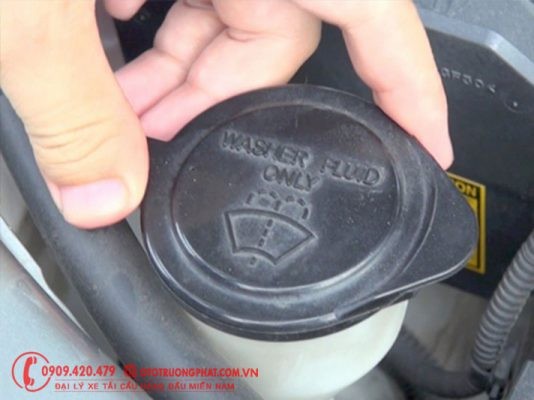Windshield washer fluid for trucks might seem like a minor detail, but it plays a crucial role in ensuring clear visibility for drivers, especially on long journeys and in harsh weather conditions. This article from Xe Tải Mỹ Đình experts will provide you with all the necessary information about refilling truck windshield washer fluid, from when to refill, what type of fluid is best, to detailed step-by-step instructions.
Why is Refilling Truck Windshield Washer Fluid a “Must-Do”?
Windshield washer fluid is not just ordinary water. It is a specialized solution formulated to:
- Remove dirt, mud, and insect debris: Especially when trucks travel long distances, the windshield is prone to getting dirty, affecting visibility. Specialized washer fluid helps clean quickly and effectively.
- Prevent fogging and smearing in the rain: Good quality washer fluids often contain components that help limit rainwater from sticking and causing blurry vision, ensuring clear visibility in rainy weather.
- Protect the windshield surface and wiper blades: Specialized washer fluid has a neutral pH, which does not cause corrosion or rust to related parts such as wiper blades and water pipes, helping to extend their lifespan.
- Prevent freezing in winter (for specialized winter fluids): In cold climates, ordinary washer fluid can freeze, causing system blockages. Winter washer fluid solves this problem.
Signs “Telling” You to Refill Truck Windshield Washer Fluid Now
Just like fuel, truck windshield washer fluid needs to be checked regularly. Here are signs indicating you need to replenish washer fluid:
- Fluid does not spray when you turn on the switch: This is the clearest sign that the washer fluid reservoir is empty.
- Fluid sprays weakly, without enough pressure: The remaining amount of fluid is too low, not enough to clean the windshield effectively.
- Warning light on the dashboard turns on (if equipped): Some modern trucks are equipped with sensors and warning lights when the washer fluid level is low.
Advice from Xe Tải Mỹ Đình experts: Make it a habit to check the washer fluid reservoir before each trip, especially long journeys or when the weather forecast predicts rain or dust.
“Dos” and “Don’ts” When Choosing Truck Windshield Washer Fluid
Don’ts:
- Use tap water or well water: Tap water contains many minerals that can cause scale buildup and nozzle clogging. Well water may contain impurities and bacteria that are not good for the system.
- Mix dish soap or detergent: These detergents can create excessive foam, damage the car’s paint, and are not effective in cleaning the windshield.
- Use washer fluid of unknown origin: Poor quality products may contain acid, causing corrosion and damage to the windshield washer system components.
Dos:
- Prioritize specialized truck windshield washer fluid: Formulated with a special formula, ensuring cleaning efficiency and protection for the windshield and system.
- Choose products with reputable brands and clear origins: Ensure quality and safety for your vehicle.
- Consider additional features: Such as rain repellent, antifreeze, and pleasant fragrance.
- Read the instructions carefully: Follow the manufacturer’s instructions for best results.
In emergencies, you can use distilled water or purified water as a temporary substitute. However, this is only a temporary solution, and you should replenish specialized washer fluid as soon as possible.
Step-by-Step Guide to Refilling Truck Windshield Washer Fluid at Home
Refilling truck windshield washer fluid is very simple, and you can easily do it yourself at home.
Step 1: Locate the windshield washer fluid reservoir.
Typically, the truck windshield washer fluid reservoir is located in the engine compartment, near the windshield, usually on the passenger side. The reservoir cap is usually blue or yellow and has a windshield wiper symbol on it.
 Windshield washer fluid reservoir location on a truck, usually indicated by a windshield wiper symbol on the cap.
Windshield washer fluid reservoir location on a truck, usually indicated by a windshield wiper symbol on the cap.
Step 2: Open the windshield washer fluid reservoir cap.
Turn or flip open the cap counterclockwise. Be careful not to break or damage the cap.
 Opening the windshield washer fluid reservoir cap to prepare for refilling with new fluid.
Opening the windshield washer fluid reservoir cap to prepare for refilling with new fluid.
Step 3: Refill with new windshield washer fluid.
Pour specialized windshield washer fluid slowly into the reservoir. Observe the fluid level inside the reservoir or through the level indicator (if available) on the reservoir wall. Note: Do not overfill; leave a small gap to prevent overflow when the vehicle is moving or the temperature changes.
Step 4: Close the reservoir cap tightly.
After refilling the required amount of fluid, close the cap tightly to prevent dirt from entering and fluid from leaking out.
Step 5: Check operation.
Get into the truck cabin, turn on the ignition, and try turning on the windshield washer fluid switch. Observe if the fluid sprays evenly and strongly. If the fluid sprays normally, the windshield washer fluid refilling process is complete.
Important note: If you want to completely replace the old washer fluid (especially when switching to a different type or if the old fluid is too dirty), spray out all the old fluid remaining in the reservoir before refilling with new fluid.
Conclusion
Refilling truck windshield washer fluid is a simple but crucial task to ensure safety and comfort on every journey. Hopefully, with this detailed guide from Xe Tải Mỹ Đình, you can confidently perform this task easily and effectively. Wishing all drivers safe travels!

